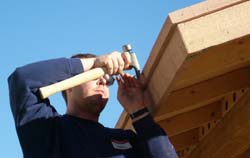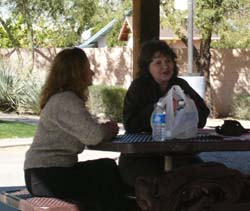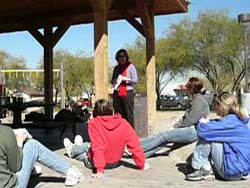 |
|
HABITAT FOR HUMANITY: Village of Hope– Field Experience Analysis. |
|

“As symbolic devices that enhance the identity of subdivisions, names also reflect place personality” – Blake/ Arreloa in Residential Subdivision Identity in Metropolitan Phoenix.
On Friday, February 6 2004, our Learning from South Phoenix class assembled at the park in the Villas Esperanza (Village of Hope), a 93 home Habitat for Humanity subdivision in South Phoenix. We arrived at 8 am. Having a chance to watch the neighborhood families heading to work and getting their kids off to school gave us all a unique perspective on daily life in the neighborhood and the people who live in it.
Today we would be adding to
the roof of a house that was in the latter stages of construction. All that was
left was our part and the next crew could start putting on the shingles. It
felt good to donate time to a worthwhile charity like Habitat for Humanity. I
also felt a connection with the people who would be living in the house: Each
family has to donate 400 hours of “sweat equity” time in order to qualify for
the loan from Habitat. Future residents must perform the first 100 hours
themselves and then can invite friends and extended family members to pitch in
on the project. The learning aspect of the experience was rewarding as well.
Tom, our supervisor for the day, gave us not only all the information we needed
to get our job done correctly, he was more that willing to discuss any aspect of
the building process in detail. (See a
short interview with Tom) After hundreds of hours of this kind of training,
residents of Villas Esperanza will most likely feel ready to tackle any problem
they may ever encounter in their new homes.
Not only do residents need
their sweat equity to qualify. Later in the afternoon we traveled to Habitat’s
South Ranch community to meet with Deborah and Missie, the associate director
and the director of development at the chapter of Habitat responsible for South
Ranch (the first ever Habitat for Humanity subdivision, as opposed to just
“in-fill” housing) and Villas Esperanza. Missy is in charge of qualifying
prospective residents for the new subdivision. She told us that families need
to qualify financially for the loan (from Habitat—not a bank), meaning they must
make between $13,992 and $53,046 depending on family size, have good enough
credit (this is the single largest disqualifier) and be first time homeowners.
Families get priority over singles, childless couples and the elderly.
An interesting condition for
owning a home in one of the Habitat subdivisions – just as in virtually every
other subdivision in the valley - is a required agreement to subject the family
to the policing of a homeowners association. These organizations are largely
responsible for Phoenix’s image as a city where, like the bland, corporate-run
Green Valley that David Guterson describes in his essay No Place Like Home,
“Neighborhoods are labyrinthine, confusing in their sameness; each block looks
eerily like the next”(Harpers Magazine 1992, Pg. 55). A Homeowners
Associations’ primary concern is keeping property values as high as possible,
through strict enforcement of rigid rules and regulations, even at the expense
of a homeowner’s lifetime’s work. The fine print of a HOA contract often
features language giving the HOA legal right to auction off the homeowner’s
house and gives them authority to have court appointed repo-men to seize and
sell off the belongings of those who don’t conform with the bylaws or pay their
dues in a timely manner (Garreau, Pg. 187-190). The presence of these HOAs also
raises questions about infringing on different cultural groups right to express
themselves through the individual appearance of their homes and front yards. In
East Los Angeles for example, it is commonplace for barrio Latinos to customize
the appearance of their 1940’s-era Anglo designed homes. (Rojas, 137) There
will likely be no place for this kind of self-expression in this Habitat for
Humanity community.
We were soon joined by Habitat’s Executive Director Christine Odom, (see an interview with Christine) who closed out the day by filling us in on some of Habitat’s history and some background information on Habitat’s longtime association with former President Jimmy Carter. Christine also talked about the new challenges facing the organization as it tries to establish itself in cities as opposed to in rural areas where Habitat got its start
Working on this project was very rewarding. It was enriching to learn more about an interesting and admirable organization like Habitat for Humanity.
back: To Czarnik Homepage
email: James.Czarnik@asu.edu